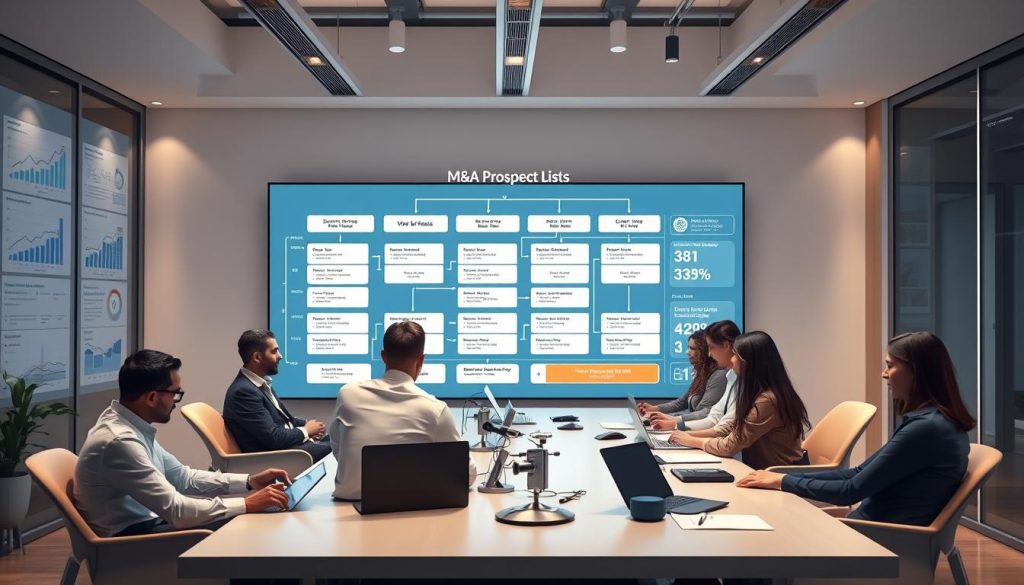In today’s fast-paced business world, M&A deal closing email tactics have become a game-changer. Companies are using targeted cold email outreach to speed up mergers and acquisitions. This approach is reshaping investor relations and startup fundraising.
Cold emails allow businesses to reach potential partners quickly and effectively. They cut through the noise of traditional communication channels. By crafting personalized messages, companies can grab attention and start meaningful conversations.
Successful M&A deals now rely on smart communication strategies. These tactics help build relationships, share key information, and move negotiations forward. For startups seeking funding, cold emails can open doors to investors they might not reach otherwise.
Key Takeaways
- Cold email outreach speeds up M&A deals
- Personalized messages are crucial for success
- Email tactics improve investor relations
- Startups can use cold emails for fundraising
- Effective communication drives faster deal closings
Understanding the M&A Landscape in Modern Deal-Making
The world of mergers and acquisitions has changed a lot lately. Venture capital firms are now key players in this field. They bring new ways to value startups and make deals.
Current Market Dynamics in Mergers and Acquisitions
The M&A market is always changing, thanks to new tech. Companies use digital platforms to find and make deals. This change opens up new chances for both startups and big companies.
Key Stakeholders in M&A Transactions
Now, more than just big companies are involved in M&A deals. Venture capitalists, private equity firms, and impact investors play big roles. Their strategies can make or break a deal.
| Stakeholder | Role in M&A | Primary Focus |
|---|---|---|
| Venture Capitalists | Funding and Advisory | High-growth potential |
| Impact Investors | Social and Financial Returns | Sustainable business models |
| Corporate Buyers | Strategic Acquisitions | Market expansion |
Evolution of Deal Communication Channels
How we talk about deals has changed a lot. Now, we use email, virtual data rooms, and video calls instead of meeting in person. These digital tools make deals faster and easier.
“The future of M&A lies in leveraging technology to connect the right buyers with the right sellers at the right time.”
As the M&A world keeps changing, it’s important to understand these shifts. This knowledge is key to success in today’s deal-making.
M&A Deal Closing Email Tactics
Closing M&A deals through email needs finesse and strategy. Personalization is crucial when contacting potential buyers or sellers. Make sure your message meets their specific needs and interests. Show how the deal fits into their business goals.
Timing is important in M&A emails. Send them during peak hours to get noticed. If you don’t get a reply, follow up in 48 hours. This shows you’re persistent yet professional.
Focus on these key elements in your emails:
- Concise subject lines that grab attention
- Clear value propositions that show the deal’s benefits
- Relevant financial data and growth projections
- A call-to-action for next steps or meetings
Include pitch decks and term sheets as attachments. These documents give a detailed look at the deal’s potential. They outline key terms, helping in quicker decision-making.
Keep communication open throughout. Have regular updates and check-ins. This builds trust and shows your commitment to clear investor relations.
“Effective email communication can significantly accelerate the M&A process, fostering stronger connections between parties and paving the way for successful deal closures.”
Using these email tactics can streamline your M&A deal closing. It boosts your success chances in today’s competitive market.
Crafting Perfect Cold Email Templates for M&A Outreach
Effective cold email templates are key for M&A outreach, especially in startup fundraising and venture capital. A well-crafted email can lead to potential deals and engage impact investors.
Subject Line Optimization for Higher Open Rates
Your subject line is your first chance to impress. Keep it short and interesting. For venture capital outreach, try “Exciting Growth Opportunity in [Industry]” or “Innovative Startup Seeking Strategic Partner.” These subject lines spark curiosity and hint at potential value.
Email Body Structure and Content Strategy
Make your email body easy to scan. Start with a brief intro, then highlight your company’s key points. For startup fundraising, focus on unique selling points, market potential, and current traction. Use bullet points to emphasize important info:
- Market size and growth potential
- Current revenue or user base
- Competitive advantages
- Team expertise
Call-to-Action Best Practices
End with a clear, compelling call-to-action. For impact investor engagement, suggest a specific next step. Examples include “Schedule a 15-minute call to discuss potential synergies” or “Request our detailed pitch deck for more information.” Make it easy for the recipient to take action and move the conversation forward.
“The best M&A outreach emails are personalized, value-focused, and action-oriented.”
By following these guidelines, you’ll create cold email templates that resonate with potential M&A partners and investors. This increases your chances of successful deals in the competitive startup and venture capital landscape.
Building Targeted Prospect Lists for M&A Opportunities
Creating a strong prospect list is key for successful M&A deals. Focus on quality over quantity to find promising opportunities that match your goals.

Begin by setting clear criteria for potential targets. Look at industry, company size, financial performance, and growth potential. This makes your due diligence easier and helps in valuing startups.
To build your list, use different data sources:
- Industry reports and market analyses
- Financial databases
- Business news and press releases
- Professional networks and referrals
Good portfolio management means updating and refining your list often. Remove inactive leads and add new ones as the market changes.
“A well-curated prospect list is the foundation of successful M&A deal-making.”
Technology can help improve your list-building. CRM systems and AI tools track interactions, analyze data, and find promising leads.
| Data Source | Benefits | Limitations |
|---|---|---|
| Industry Reports | Comprehensive market overview | May lag behind real-time changes |
| Financial Databases | Accurate financial data | Limited information on private companies |
| Business News | Real-time updates | May contain speculative information |
| Professional Networks | Insider insights | Limited scope and potential bias |
By using these strategies, you’ll have a targeted prospect list. This list will fuel your M&A pipeline and help you achieve successful deals.
Leveraging Data Analytics for Deal Pipeline Management
Data analytics changes how we manage M&A deal pipelines. It helps firms make better choices, make things more efficient, and increase success. Let’s see how analytics improves finding the right prospects, managing deals, and tracking performance.
Data-Driven Prospect Qualification
Using data smartly makes picking prospects better. Companies look at financials, market standing, and growth chances to find the best targets. This method matches well with exit plans and term sheets, ensuring a good match from the start.
Deal Flow Optimization Metrics
Important metrics help improve deal flow:
- Deal velocity: Time from first contact to closing
- Conversion rates: How well prospects move through the pipeline
- Deal value distribution: Range and average of deal sizes
These metrics help firms tweak their investor relations and make deal flow better.
Performance Tracking and Analysis
Tracking performance is key. Companies watch how well outreach works, response rates, and how fast deals close. This info helps adjust strategies and use resources better, boosting ROI on M&A efforts.
| Metric | Purpose | Impact |
|---|---|---|
| Deal Velocity | Measure efficiency | Faster closings |
| Conversion Rates | Assess pipeline health | Improved targeting |
| Value Distribution | Understand deal landscape | Optimized resource allocation |
By using these analytics, M&A teams can improve their methods. This leads to more successful deals and stronger ties with investors.
Due Diligence Communication Strategies

Good communication is key in M&A deals. Startups need to get this right to get funding. Clear talks can make a deal succeed.
It’s important to manage information well. Use secure data rooms for pitch decks and financials. This keeps things private but easy to access for investors. Make sure files are organized to help everyone review faster.
Quickly answer any questions. Be ready to explain any financial issues. Being open builds trust, which is crucial for getting funding. Try to respond to questions within a day to keep things moving.
“Transparent communication during due diligence can significantly reduce time-to-close for M&A deals.”
Use digital tools to keep everyone updated. Video calls can save time and money. Use project management software to track who needs what and when.
Due diligence is a two-way street. Investors check you out, and you check them. Ask about their investment plans and support. This shows you’re serious about finding the best partner for your startup.
Negotiation Techniques Through Digital Channels
Digital channels have changed M&A negotiations. Now, virtual platforms are key for talks on term sheets and exit strategies. This new world needs different skills for deal-makers to succeed.
Virtual Meeting Optimization
Virtual meetings need careful planning. Make sure everyone knows the agenda and use top-notch tech. It’s also important to listen well. This helps build trust and rapport with impact investors.
Digital Document Exchange Protocols
Securely sharing documents is crucial in M&A deals. Use encrypted sites for sensitive info like term sheets. Also, keep track of changes with version control systems.
Remote Deal Closing Best Practices
Remote deal closing needs thorough prep. Make detailed checklists for everyone. Use digital signatures for speed. Make sure all know the exit strategies before agreeing.
“Digital negotiations demand adaptability. Embrace new tools and techniques to close deals effectively in the virtual realm.”
By learning these digital negotiation skills, M&A pros can handle today’s deal-making with confidence and precision.
Conclusion
In today’s fast-paced M&A world, knowing how to close deals quickly is key. Using the right email tactics can make transactions faster and improve relations with investors. By sending targeted cold emails, dealmakers can reach the right people more easily.
Smart outreach in portfolio management is very beneficial. Using data helps find the right prospects and manage deals better. This leads to better results and quicker closings. Now, virtual meetings and digital document sharing are common, requiring new skills.
To thrive in modern M&A, use these digital tools and strategies. Improve your email templates, create strong lists of prospects, and keep track of your results. With time and effort, you’ll close deals faster and build strong relationships in the changing world of mergers and acquisitions.
FAQ
How can targeted cold email outreach accelerate M&A deal closings?
Targeted cold email outreach helps speed up M&A deal closings. It lets you talk directly to potential partners. This makes it easier to present opportunities and get a quick response.
It’s all about personalized messages, fast follow-ups, and reaching decision-makers. This streamlines the early M&A stages.
What are some key elements of an effective M&A outreach email?
An effective M&A outreach email has a catchy subject line and a personalized start. It clearly states the value you offer and shares relevant company info. A strong call-to-action is also key.
Keep it short and focus on the deal’s benefits. Tailor the content to the recipient and their company.
How important is timing in M&A email outreach?
Timing is very important in M&A email outreach. The right time can greatly improve open rates and responses. Mid-week mornings are often good, but consider the industry and time zone.
Also, time your emails to match market conditions and the target company’s situation. This makes your emails more relevant and interesting.
What role does data analytics play in M&A deal pipeline management?
Data analytics is key in managing M&A deal pipelines. It helps qualify prospects, manage deal flow, and track performance. It finds promising opportunities and predicts success.
It also refines outreach strategies based on data and trends. This improves the M&A process’s efficiency and success.
How can due diligence communication be effectively managed through email?
Effective due diligence communication through email involves clear info requests and secure document sharing. Keep emails concise and well-structured. Use secure platforms for sensitive documents.
Regular updates are also important. This streamlines the due diligence process and keeps things moving.
What are some best practices for remote M&A deal closing?
For remote M&A deal closings, use secure digital signatures and conduct thorough virtual meetings. Ensure clear communication for any last-minute changes. Have a checklist for all documents and procedures.
Plan for technical issues and check legal requirements for remote closings. This ensures a smooth process.
How can I build and maintain a high-quality prospect list for M&A opportunities?
To build a quality prospect list, use industry databases, financial reports, and news. Update the list with market changes and company performances. Use CRM tools to track and qualify prospects.
Networking events and conferences can also help expand your list. This way, you can find potential targets or acquirers.
What strategies can be used to optimize subject lines for M&A outreach emails?
To optimize subject lines, keep them short (around 40 characters) and personalized. Create a sense of urgency or curiosity. Use action words and avoid spam triggers.
Test different subject lines to see what works best. Mentioning the deal’s value can also boost open rates.
How can I effectively negotiate M&A terms through digital channels?
To negotiate M&A terms digitally, prioritize clear and frequent communication. Use video conferencing for face-to-face talks and screen sharing for document review. Employ secure platforms for confidential info.
Set clear agendas for meetings and follow up with email summaries. Be careful of digital miscommunications and clarify important points in writing.
What are some common pitfalls to avoid in M&A email outreach?
Avoid using generic templates without personalization. Don’t overwhelm recipients with too much info in the first email. Follow up properly and clearly state the deal’s value.
Be mindful of timing, research the target company, and have a clear call-to-action. Avoid pressuring or manipulative language.


